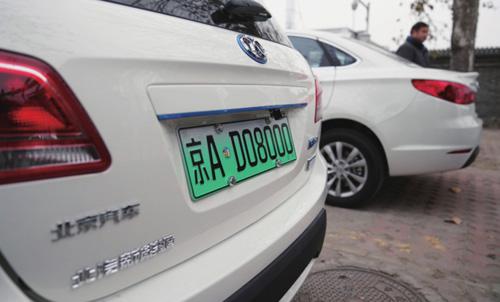Green Machines
By Xia Yuanyuan
Due to low costs and emissions, new- energy vehicles (NEVs) are becoming increasingly popular worldwide.
On the streets of Beijing, NEVs are distinguishable by their six-digit, bright green license plates. And a quick look around the streets of the capital will reveal more and more of these unique plates on display as this form of transport gains in popularity.
Taking cognizance of this popularity from an increasingly environmentally conscious public, on March 1, the National NEV Technology Innovation Center was unveiled in the Beijing Economic-Technological Development Area. The center will coordinate the development of the industry supported by the Ministry of Science and Technology and the Beijing Municipal Government.
NEVs are vehicles powered by nontraditional fuel such as electric cars. Thanks to favorable government policies, Chinas NEV market has seen rapid growth in recent years.
China has been the worlds largest market for NEVs for three consecutive years. According to the China Association of Automobile Manufacturers (CAAM), NEV output and sales jumped by 142.4 percent and 149.2 percent year on year to reach 232,000 and 225,000 in the fi rst four months of 2018. For 2017, a total of 777,000 NEVs were sold in the Chinese market, up 53.3 percent year on year.
Charged up
Li Xian, an office worker in Beijing, bought an NEV last year immediately after receiving his license plate. In Beijing, those who want to obtain NEVs have to join a waiting list for license plates after submitting an application form.
“Actually, an electric car was not my fi rst choice. Charging was the fi rst problem that made me hesitant,” Li said. But his concerns were dispelled when the seller set up an electric charging point in the parking lot of his apartment block. “It is convenient as the car can be fully charged within eight hours of getting home,” Li added. According to data from the China Electric Vehicle Charging Infrastructure Promotion Alliance, by January, the total number of charging points in China had reached 450,000. Of this total, 220,000 are publicly available.
Additionally, car manufacturers have made great achievements in developing batteries that allow greater range. NEVs capable of a range of 400 km and above on one charge came into the market earlier this year, which has satisfi ed consumers requirement on increasing mileage.
To promote the industry, the Chinese Government issued a policy providing sub-sidies for manufacturers and purchasers, which has provided a significant boost for the NEV market.
Jiang Wei, who got his NEV license plate at the beginning of this year, plans to buy an electric car for 180,000 yuan($28,500). The Central Government will provide a subsidy of 45,000 yuan ($7,100), while the Beijing Municipal Government will provide another 45,000 yuan, effectively halving the price of the car. He will also benefi t from a ruling that exempts NEVs from purchase tax, which will save him a further 7,500 yuan($1,190).
In addition, the cost of an NEV is far lower than a traditional car. “Over 100 km, an NEV consumes less than 10 yuan ($1.6) of electricity, but it costs over 50 yuan ($8) for a petrol vehicle,” Meng Xiangkun, a salesman for the new-energy automaker BYD, said.
In addition, the noise and vibration levels of NEVs during operation are much lower than those of conventional internal combustion engines. This feature of electric vehicles will help make them quieter and the ride smoother.
Green effects
As China promotes green development, cities are at the forefront of changes in energy, mobility and consumption. Across regions, cities are experimenting with ways to improve air quality, reduce congestion and provide clean, reliable and affordable energy to their growing populations.
The electrification of transport supports national and local ambitions for cleaner mobility. Experts believe that the promotion of NEVs is one of the ways for China to realize its goal of reducing carbon emissions per 10,000 yuan($1,587) of GDP by 60-65 percent compared to 2005 levels by 2030. The goal was described in the Intended Nationally Determined Contribution that China pledged to the UN Framework Convention on Climate Change in June 2015.
According to a report issued by the World Economic Forum in February, even without significant changes in the sources of electricity generation—primarily coal, natural gas and renewables—an electric vehicle can still reduce carbon dioxide emissions by 60 percent compared with internal-combustion engines.
Observers noted that the popularity of NEVs is inseparable from the Chinese Governments support and implementation of related policies. The government encourages local governments, public institutions and bus companies to use more NEVs.
The Report on the Work of the Government delivered by Premier Li Keqiang at the opening meeting of the First Session of the 13th National Peoples Congress in March, stated that China will support the purchase of NEVs and continue to waive purchase taxes during the 2018-20 period to encourage green transportation.
Chinas banking authorities also announced new loan policies to allow the buyers of NEVs to borrow a larger portion of the purchase price. Starting from 2018, NEV buyers will be able to borrow up to 85 percent of the cost from banks, up from 80 percent.
Specifically, electric passenger cars with a range of 400 km and above on one charge will receive more subsidies, increasing by almost 14 percent from the 2017 level.
“The new policy will stimulate greater growth potential and technological improvement in the sector,” said Meng.
Recycling challenge
According to a government plan, the annual output and sales of NEVs is expected to hit 2 million by 2020. Although the environmental benefits of explosive NEV growth are clear, it also brings a challenge in the form of battery recycling.
“If car batteries are not properly handled, they may explode. Acidic substances that are needed to process the batteries are also hazardous to humans and may pollute air and soil,” Zhang Zheming, assistant researcher with Shenzhen Institutes of Advanced Technology, told Xinhua News Agency.
According to Shenzhen Gaogong Industry Research Co. Ltd., in 2016 there were around 12,000 tons of car batteries that needed recycling, and this figure is expected to jump to 248,000 tons by 2020.
In February, the Chinese Government published a guideline on recycling NEV batteries. According to a document jointly released by the Ministry of Industry and Information Technology and six other government departments, electric car makers should be responsible for building a recycling network for used batteries. The research of NEV battery recycling is to be encouraged and cooperation between research institutions and industrial entities supported.

